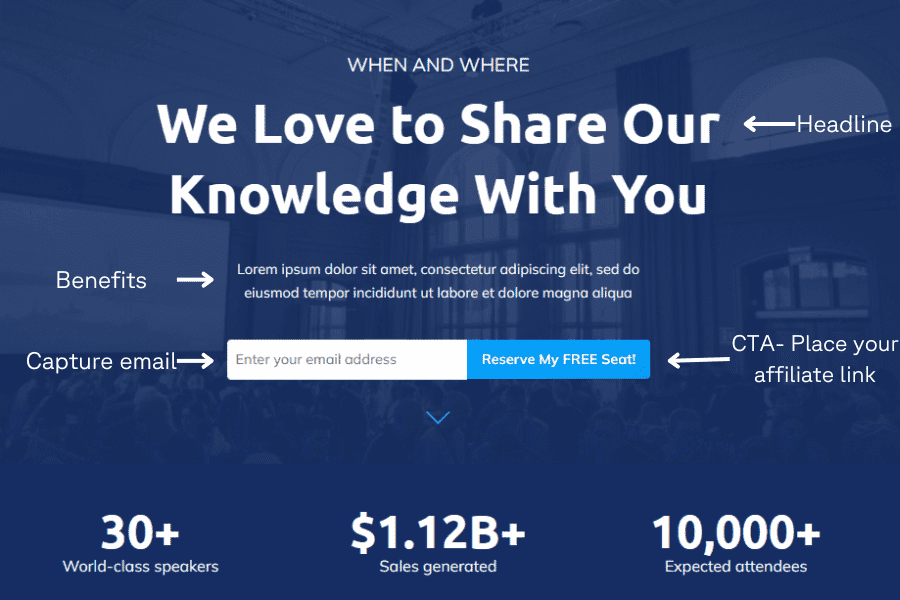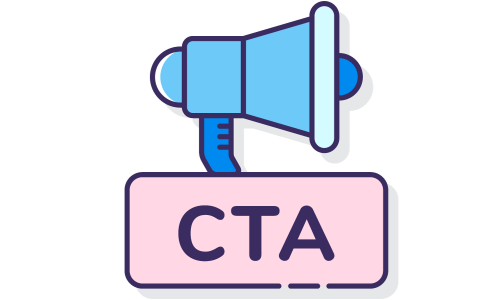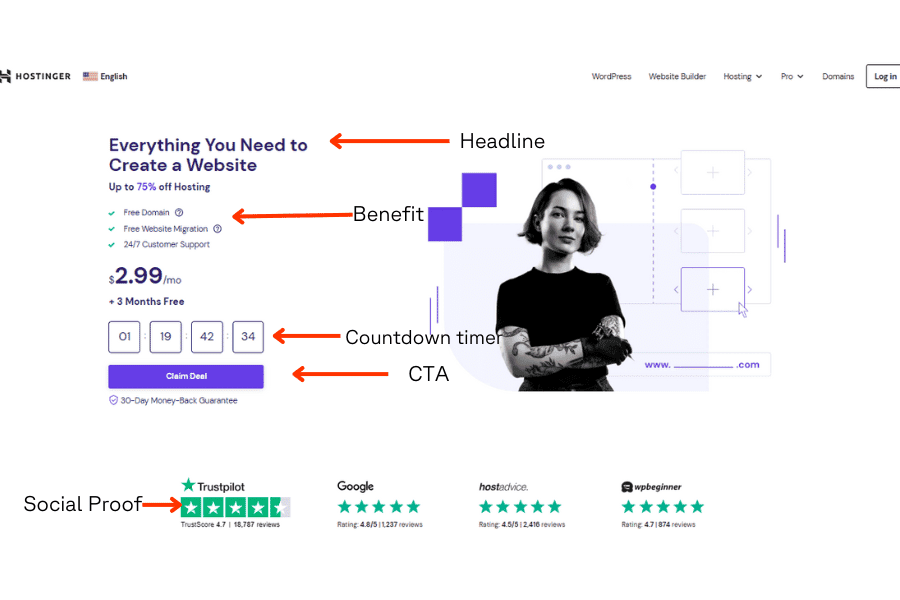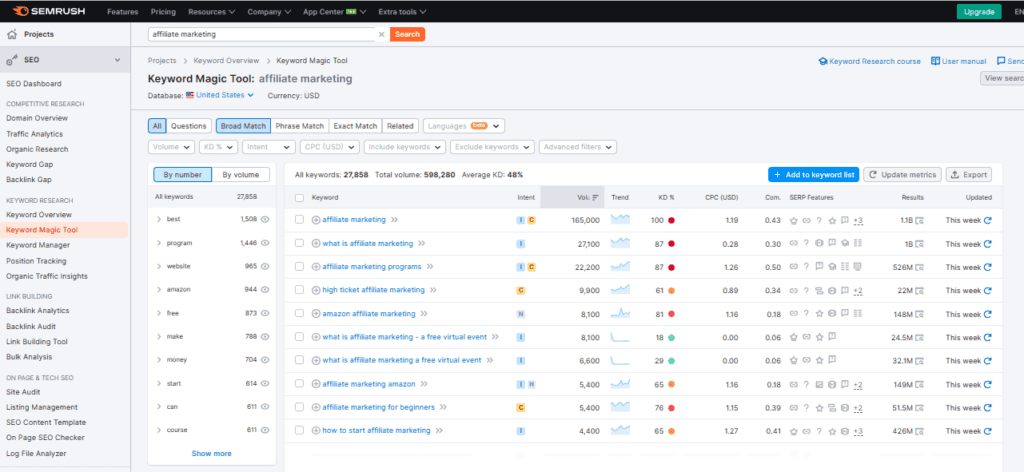How to Build an Optimized affiliate Marketing landing page in 2024
Introduction:
An effective affiliate marketing landing page can make the difference between successful and lackluster affiliate campaigns. Whether you’re a seasoned affiliate marketer or just starting, understanding the importance of creating and optimizing an affiliate marketing landing page is crucial to your success.
Key Takeaways:
What is an Affiliate marketing landing Page?
An affiliate marketing landing page is a dedicated web page to promote and drive traffic to an affiliate offer. It serves as the intermediary between the affiliate marketer and the target customers to convince the visitor to take a desired action, such as purchasing or providing their email addresses.
Unlike a traditional website or blog, an affiliate marketing landing page is focused on a single goal and eliminates distractions that may lead visitors astray. It typically includes persuasive copy, compelling visuals, and strategically placed affiliate links or call-to-action buttons.


A minimalistic affiliate marketing landing page but very effective. It has a headline, benefits, capture email, and CTA where you place the affiliate link. This simple landing page was created using Systeme.io. You can build your landing page for free. Try their Free Forever plan landing page builder.




Systeme.io
Systeme.io is the best way to start and scale your online business. It gives you everything you need to create sales funnels, landing pages, email campaigns, online courses, and more. And it’s incredibly affordable – you can get started for free and pay as you grow. Don’t miss this opportunity – sign up for the Free Version Forever Plan now.
Importance of Creating an Effective Affiliate Marketing Landing Page
Creating an effective affiliate marketing landing page is vital for several reasons:
- Increased Conversion Rates: An optimized affiliate marketing landing page can significantly boost your conversion rates. By presenting a clear value proposition, addressing the pain points of your target audience, and providing compelling reasons to take action, you can drive more visitors to convert into customers.
- Enhanced Relevance: An affiliate marketing landing page allows you to tailor your message specifically to the target audience of the affiliate offer. By aligning the content, visuals, and overall user experience with the needs and interests of your potential buyers, you increase the relevance of your offer and improve the chances of conversion.
- Improved Ad Quality Score: In many affiliate marketing programs, the success of your advertising campaigns depends on the quality of your affiliate marketing landing page. By creating high-quality landing pages that provide value to users and align with the ad content, you can improve your ad quality score, leading to lower advertising costs and better ad placements.
- Better Tracking and Analytics: With a dedicated landing page, you gain valuable insights into the performance of your affiliate marketing efforts. You can track metrics such as click-through, conversion, and bounce rates, allowing you to analyze and optimize your campaigns based on accurate data.
- Building Trust and Credibility: A well-designed affiliate marketing landing page with persuading content and trust elements can build your audience’s trust and credibility. By providing valuable information, showcasing testimonials or reviews, and transparently disclosing affiliate relationships, you can make a strong reputation and foster long-term relationships with your audience.
By understanding the meaning of an affiliate marketing landing page and the significance of developing an effective one, you are able to create and optimize your landing sales page.
Understanding the Target Audience
You must deeply understand your target audience to create an effective affiliate landing page. By identifying your target market and niche, conducting thorough market research, and creating detailed buyer personas, you can tailor your landing page to resonate with your ideal customers.
Identifying the Target Market and Niche
Start by clearly defining your target market and niche. Consider the demographics, interests, and pain points of your potential customers. Identify those most likely to be intrigued by the affiliate offer you are promoting. By narrowing your target audience, you can create a landing page that speaks directly to their requirements and is more compelling.
Conducting Market Research
Market research is a crucial step in understanding your target audience. Explore your industry deeply and explore competitor websites, blogs, and social media channels. Look for common themes, customer preferences, and gaps in the market. Analyze customer reviews, forums, and online communities to gather insights and identify challenges or desires your target audience may have.
Creating Buyer Personas
Once you have gathered sufficient data from your market research, it’s time to create detailed buyer personas. A buyer persona is a fictional representation of your ideal customer based on real data and insights. It helps you understand their motivations, behaviors, and pain points, allowing you to create a personalized landing page that resonates with them.
When creating buyer personas, consider demographics such as age, gender, location, and income level. Dive deeper into their interests, hobbies, and values. Think about their goals, challenges, and objections regarding the affiliate offer you’re promoting. The more detailed and specific your buyer personas are, the more precisely you can tailor your landing page to meet their requirements.
Buyer Persona:


Source: Image by Freepik
Understanding your target audience is the foundation of a successful affiliate marketing landing page. By identifying your target market and niche, conducting thorough market research, and creating detailed buyer personas, you’ll have the insights to create a landing page that speaks directly to your ideal customers’ needs and desires.
Setting Clear Goals
Setting clear goals is essential before you start creating your affiliate landing page. By defining the purpose of the landing page, establishing measurable objectives, and identifying key performance indicators (KPIs), you can track the success of your efforts and optimize your landing page for maximum impact.
Setting clear goals is essential before you start creating your affiliate landing page. By defining the purpose of the landing page, establishing measurable objectives, and identifying key performance indicators (KPIs), you can track the success of your efforts and optimize your landing page for maximum impact.
Defining the Purpose of the Landing Page
Begin by determining the primary purpose of your landing page. Are you aiming to generate sales, capture leads, promote a specific product or service, or build brand awareness? Clarifying the purpose will guide your decision-making when crafting the landing page’s content, design, and call-to-action elements.
For instance, if your goal is to generate sales, you might focus on persuasive copy, compelling product visuals, and a streamlined checkout process. If your objective is lead generation, you may prioritize capturing visitor contact information through a well-placed opt-in form.
Establishing Measurable Objectives
Once you’ve defined the purpose, it’s crucial to establish measurable objectives for your landing page. Measurable objectives provide clear targets to strive for and enable you to track your progress. For example, you aim to achieve a certain number of sales, generate a specific number of leads, or increase click-through rates by a certain percentage.
Ensure your objectives are specific, measurable, achievable, relevant, and time-bound (SMART goals). This framework helps you set realistic and actionable targets that contribute to the overall success of your affiliate marketing campaign.
Identifying Key Performance Indicators (KPIs)
To measure the effectiveness of your landing page, it’s important to identify key performance indicators (KPIs) that align with your objectives. KPIs are specific metrics that indicate the performance and success of your landing page.
The KPIs you choose will depend on your goals and the nature of your affiliate offer. Common KPIs for affiliate landing pages include conversion rate (the percentage of visitors who take the desired action), click-through rate (the percentage of visitors who click on your affiliate links or CTAs), bounce rate (the percentage of visitors who leave the page without taking any action), and average time on page.
By monitoring and analyzing these KPIs, you can gain insights into your landing page’s effectiveness and make data-driven optimization decisions.


Regularly track and review your progress against your established objectives and KPIs. If your landing page needs to meet your goals, you can adjust the content, design, or layout to improve performance.
Setting clear goals, establishing measurable objectives, and identifying key performance indicators are crucial steps in creating an effective affiliate landing page. By aligning your landing page with your objectives and tracking its performance through relevant KPIs, you can optimize your page for maximum conversions and achieve your affiliate marketing goals.
Crafting Compelling Content
Compelling content is one of the critical elements of an effective affiliate marketing landing page. By crafting an attention-grabbing headline, writing persuasive copy, utilizing storytelling techniques, and incorporating strong calls to action (CTAs), you can engage your visitors and increase the chances of conversion.
Writing a Captivating Headline
The headline of your landing page is the first thing visitors see, and it plays a crucial role in capturing their attention. To write a captivating headline, consider the following tips:
- Be clear and concise: Communicate your offer’s value proposition or main benefit concisely and straightforwardly.
- Create a sense of urgency: Use words or phrases that convey urgency to encourage visitors to take immediate action.
- Highlight a unique selling point: Identify what sets your offer apart from others and emphasize it in your headline.
- Use powerful words: Incorporate solid and persuasive words that evoke emotions and grab attention.
Crafting Persuasive Copy
Once you’ve captured your visitors’ attention with a captivating headline, it’s essential to keep them engaged with persuasive copy throughout your landing page. Here are some tips for crafting persuasive copy:
- Know your audience: Tailor your copy to resonate with your target audience’s pain points, desires, and motivations.
- Highlight the benefits: Communicate the benefits and advantages of the affiliate offer. Show how it solves a problem or fulfills a need.
- Use social proof: Incorporate testimonials, reviews, or case studies to build trust and credibility.
- Address objections: Anticipate and address potential objections or concerns your audience may have and provide reassurance or solutions.
- Keep it scannable: Use subheadings, bullet points, and short paragraphs to make your copy easy to scan and digest.
Utilizing Storytelling Techniques
Storytelling is a powerful tool to engage and connect with your audience emotionally. Consider incorporating storytelling techniques into your landing page to make it more memorable and impactful. Tell a story that resonates with your audience, highlighting how the affiliate offer has transformed someone’s life or solved a problem. Incorporating Strong Calls to Action (CTAs)
A solid call to action (CTA) is essential to guide visitors toward the desired action on your landing page. Here are some best practices for creating effective CTAs:


- Be clear and specific: Clearly state what specific action you want visitors to take, such as “Buy Now,” “Sign Up Today,” or “Download the Guide.”
- Use action-oriented language: Utilize verbs that generate a sense of urgency and encourage site visitors to act.
- Make it visually prominent: Use contrasting colors, bold fonts, or buttons to make your Call-to-action button stand out from the rest of the page.
- Create a sense of value: Convey the benefits or rewards visitors receive by taking the desired action.
- Consider multiple CTAs: Depending on the length of your landing page, strategically place strong CTA at different sections to ensure visitors always have a clear next step.
By crafting compelling content, you can engage your visitors and increase the chances of conversion on your affiliate landing page.


I cannot overemphasize the importance of an effective and optimized affiliate marketing landing page. The best free forever plan landing page builder I have used is Systeme.io. If you are using another platform, you can try our Start-up Plan, where you will get a special 30% discount plus free migration to our platform.




Systeme.io
Systeme.io is the best way to start and scale your online business. It gives you everything you need to create sales funnels, landing pages, email campaigns, online courses, and more. And it’s incredibly affordable – you can get started for free and pay as you grow. Don’t miss this opportunity – sign up for the Free Version Forever Plan now.
Designing an Engaging Layout
The layout of your affiliate landing page plays a vital role in capturing and maintaining your visitors’ attention. By choosing an appropriate color scheme and fonts, optimizing for mobile responsiveness, structuring the page with clear sections, and using high-quality images and visuals, you can create an engaging and visually appealing experience for your audience.
Choosing an Appropriate Color Scheme and Fonts
The color scheme and fonts you choose for your landing page significantly impact its visual appeal and readability. Consider the following tips:
- Consistency: Select a color scheme that aligns with your brand and remains consistent throughout the page. This helps create a cohesive and professional look.
- Contrast: Ensure that the color contrast between the text and the background is sufficient for easy reading. Avoid using overly bright or distracting colors.
- Readability: Choose easily read and legible fonts across different devices. Stick to a maximum of two or three font styles to maintain visual harmony.
Optimizing for Mobile Responsiveness
With the increasing use of mobile devices, optimizing your landing page for mobile responsiveness is essential. Ensure that your page is designed to adapt seamlessly to different screen sizes, allowing visitors a consistent and user-friendly experience regardless of their device.
Structuring the Page with Clear Sections
An organized and well-structured landing page helps visitors navigate and understand the content more easily. Consider the following tips:
- Use headings and subheadings: Break your content into sections using clear headings and subheadings. This helps visitors quickly scan and find the information they’re looking for.
- Visual hierarchy: Utilize different font sizes, colors, and formatting techniques to create a visual hierarchy that directs the visitors’ attention to the most critical elements on the page.
- White space: Incorporate ample white space between sections and elements to give the content room to breathe. This enhances readability and prevents a cluttered appearance.
Using High-Quality Images and Visuals
Images and visuals are crucial in capturing attention and quickly conveying information. Consider the following tips:
- Use relevant images: Incorporate images directly related to the affiliate offer or help illustrate its benefits. Choose high-quality and compelling visuals that resonate with your target audience.
- Optimize file sizes: Compress images without compromising quality to ensure fast page loading times.
- Videos and infographics: Consider using videos or infographics to engage and educate visitors. They can be powerful tools to convey complex information visually appealingly.


Balance images and visuals with the overall page design, ensuring they enhance the content and support your messaging without overwhelming visitors.
By designing an engaging layout, you can create a visually appealing and user-friendly experience for your visitors.
Implementing Effective SEO Strategies
To maximize the visibility and organic reach of your affiliate landing page, implementing effective search engine optimization (SEO) strategies is important. By conducting keyword research, optimizing meta tags and descriptions, creating unique and valuable content, and optimizing page load speed, you can improve your page’s search engine rankings and attract targeted organic traffic.
Conducting Keyword Research
Keyword research is identifying the search terms and phrases your target audience uses when looking for information related to your affiliate offer. By understanding the keywords relevant to your niche, you can optimize your landing page to align with your audience’s search intent. Consider the following tips:
- Use keyword research tools: Utilize tools like Google Keyword Planner, SEMrush, or Ahrefs to identify relevant keywords, search volume, and competition level.
- Focus on long-tail keywords: Long-tail keywords are more specific and targeted phrases that often have less competition. Incorporating long-tail keywords into your content can help you rank higher for niche searches.
- Consider user intent: Understand the intent behind different keywords. Are users looking for information, trying to make a purchase, or seeking reviews? Tailor your content to meet their specific needs.


Semrush Keyword Research Tool
Optimizing Meta Tags and Descriptions
Meta tags and descriptions summarize your landing page’s content to search engines and users. Optimizing these elements can improve your page’s visibility and click-through rates in search engine results. Consider the following tips:
- Title tag: Craft a concise and descriptive title tag with your target keywords. Place the most important keywords closer to the beginning of the title.
- Meta description: Write a compelling meta description that accurately summarizes your landing page’s content. Incorporate relevant keywords naturally and consider including a call-to-action to entice users to click.
- URL structure: Optimize your landing page URL to include relevant keywords. Use hyphens to separate words for better readability.
Creating Unique and Valuable Content
Creating unique and valuable content is crucial for SEO and engaging your visitors. Consider the following tips:
- Avoid duplicate content: Ensure your affiliate marketing landing page offers original and unique content. Search engines prioritize new and valuable information.
- Provide value to the audience: Address your target audience’s pain points and needs with informative, actionable, and well-structured content. Offer solutions, tips, or insights that demonstrate your expertise.
- Use headers and subheadings: Organize your content with headers and subheadings. This helps search engines understand the structure and hierarchy of your content.
Optimizing Page Load Speed
Page load speed is an important factor in user experience and SEO. A slow-loading page can result in higher bounce rates and lower search engine rankings. Consider the following tips to optimize page load speed:
- Compress images: Reduce image file sizes without compromising quality. Use compression tools to optimize your images for the web.
- Minimize code: Eliminate unnecessary code and reduce the file size of CSS and JavaScript files.
- Enable browser caching: Enable browser caching to store static files locally, reducing the time it takes to load subsequent visits.
- Use a content delivery network (CDN): Utilize a CDN to distribute your website’s files across multiple servers, improving loading times for users in different locations.


By implementing effective SEO strategies, you can improve your affiliate landing page’s visibility in search engine results and attract targeted organic traffic. Conduct thorough keyword research, optimize meta tags and descriptions, create unique and valuable content, and optimize page load speed to enhance your page’s SEO performance.
Integrating Affiliate Links and Offers
Integrating affiliate links and offers seamlessly into your affiliate marketing landing page is key to successful affiliate marketing. By selecting relevant affiliate products or services, placing affiliate links strategically, and disclosing affiliate relationships transparently, you can effectively monetize your landing page and build trust with your audience.
Selecting Relevant Affiliate Products or Services
Choose affiliate products or services relevant to your target audience and align them with the purpose of your landing page. Consider the following tips:
- Know your target market: Gain a deep understanding of your target audience’s needs, preferences, and pain points. Select an affiliate program that addresses these needs and provides value to your audience.
- Align with your content: Ensure that the affiliate product or service complements the content on your landing page. The offer should be a natural extension of your information or solution.
- Research the product or service: Evaluate the affiliate offer’s quality, reputation, and relevance. Consider factors such as customer reviews, brand credibility, and commission rates.
Placing Affiliate Links Strategically
Strategic placement of an affiliate link can significantly impact click-through rates and conversions. Consider the following tips:
- Contextual relevance: Integrate affiliate links within your content where they naturally fit and provide value to the reader. For example, you can include links within product reviews, comparison tables, or relevant informational sections.
- Call-to-action (CTA) buttons: Use visually prominent CTA buttons that indicate the next step, such as “Buy Now,” “Get Offer,” or “Sign Up.” Place these buttons strategically, ensuring they stand out without being overly intrusive.
- Multiple touchpoints: Consider placing affiliate links at multiple locations throughout your landing page. This provides more opportunities for visitors to click on the links and increases the chances of conversion.
- Test and track: Monitor the performance of your affiliate links and experiment with different placements and formats. Analyze click-through rates and conversion rates to optimize their effectiveness.
Disclosing Affiliate Relationships Transparently
Maintaining transparency and disclosing your affiliate relationships is essential to build trust with your audience. Consider the following tips:
- Use clear language: Disclose your affiliate relationships and explain that you may earn a commission from qualifying purchases or actions.
- Placement: Ensure that your affiliate disclosure is placed prominently and visibly on your landing page, ideally near the affiliate links or in a noticeable location such as the footer.
- Compliance with regulations: Familiarize yourself with relevant affiliate marketing regulations and guidelines, such as the Federal Trade Commission (FTC) guidelines in the United States. Adhere to these regulations to maintain transparency and avoid any legal issues
Transparently disclosing your affiliate relationships demonstrates your integrity and helps establish trust with your audience. It reassures them that you have their best interests in mind when recommending affiliate products or services.


By integrating affiliate links and offers in a relevant and strategic manner. By being transparent about your affiliate relationships, you can effectively monetize your landing page while building trust with your audience.
Related Article: “How to build an evergreen sales funnel that converts in 2023“
A/B Testing and Conversion Optimization
A critical aspect of building and optimizing an affiliate landing page is continuous testing and optimization to improve conversion rates. You can optimize its performance and achieve higher conversions by conducting A/B tests, analyzing data, making data-driven decisions, and iterating on your landing page.
Split Testing Different Elements of the Landing Page
A/B testing, or split testing, involves creating multiple versions of your landing page and testing different elements to determine which variations perform better. Here are some elements you can test:
- Headlines: Test different headline variations to see which ones attract more attention and generate higher engagement.
- Call-to-action (CTA) buttons: Experiment with different CTA button colors, sizes, text, or placement to identify the most effective combination.
- Layout and design: Test different layouts, color schemes, font styles, or visual elements to determine which design resonates better with your audience.
- Content variations: Test different content lengths, formats, or positioning of crucial information to see which variations lead to higher conversions.
Analyzing Data and Making Data-Driven Decisions
Collecting and analyzing data is essential for understanding how your landing page is performing and making informed decisions. Consider the following steps:
- Set up analytics: Install a web analytics tool, such as Google Analytics, to track visitor behavior, conversion rates, bounce rates, and other relevant metrics.
- Define conversion goals: Define your conversion goals, whether purchasing, filling out a form, or subscribing to a newsletter. Track these goals to measure the effectiveness of your landing page.
- Analyze data: Regularly review your analytics data to identify patterns, trends, and areas for improvement. Look for pages with high bounce rates, low conversion rates, or significant drop-offs in the conversion funnel.
- Identify areas for improvement: Use data insights to pinpoint specific elements or sections of your landing page that may be underperforming or causing friction for visitors.
Iterating and Optimizing for Higher Conversions
Based on the data analysis, make iterative changes and optimizations to your landing page to improve conversion rates. Consider the following strategies:
- Implement changes gradually: Make one change at a time and compare it to the original. This enables you to measure the impact of each change accurately.
- Monitor results: Track and compare the performance of different variations to determine which changes positively impact conversions.
- Iterate and refine: Continuously refine your landing page based on the insights gained from A/B testing and data analysis. Make data-driven decisions to improve elements that are not performing well.
Optimization is an ongoing process, and what works for one landing page may not necessarily work for another. Regularly test and optimize different elements to ensure your landing page improves and maximizes its conversion potential.
Tracking and Analyzing Performance
Tracking and analyzing the performance of your affiliate landing page is key for understanding its effectiveness and making data-driven decisions. By setting up analytics tools, monitoring key metrics and conversions, and making adjustments based on performance data, you can optimize your landing page for better results.
Setting Up Analytics Tools
To track the performance of your affiliate landing page accurately, it’s essential to set up analytics tools. Here are some steps to consider:
- Choose an analytics platform: Select a reliable analytics platform, such as Google Analytics, that offers robust tracking capabilities and provides valuable insights into user behavior and conversion metrics.
- Install tracking codes: Implement the tracking code provided by the analytics platform on your landing page. This code will enable data collection about visitor interactions, traffic sources, and conversions.
- Set up conversion tracking: Define conversion goals in your analytics tool to track specific actions that indicate successful conversions, such as form submissions, purchases, or sign-ups.


Monitoring Key Metrics and Conversions
Once you have set up analytics tools, monitoring key metrics and conversions is vital to gain insights into your landing page’s performance. Consider the following metrics:
- Traffic sources: Identify the channels that drive traffic to your landing page, such as organic search, social media, or email campaigns. This helps you understand where your most valuable traffic comes from.
- Bounce rate: Monitor the bounce rate, representing the proportion of visitors who abandon your landing page without taking additional action. A high bounce rate may suggest your landing page is not engaging or relevant enough to your audience.
- Conversion rate: Track the conversion rate to measure the percentage of visitors who complete the desired action, such as purchasing or submitting a form. This metric reflects the effectiveness of your landing page in driving conversions.
- Average time on page: Analyze visitors’ average time on your landing page. A longer time on the page suggests that visitors engage with your content, while a short time may indicate that your content is not holding their attention.
Making Adjustments Based on Performance Data
You can make informed adjustments to optimize your landing page based on the insights from tracking and monitoring performance data. Consider the following actions:
- Identify strengths and weaknesses: Analyze the performance metrics to identify areas of your landing page that are performing well and those that need improvement. This can include headlines, CTA buttons, or content sections.
- Test and iterate: Implement A/B testing to experiment with different variations of the underperforming elements. Test headlines, colors, layouts, or content formats to determine what resonates best with your audience.
- Make data-driven decisions: Rely on the data and insights gathered from your analytics tools to make informed decisions. Avoid making changes based on assumptions or personal preferences alone.
- Continuously optimize: Optimization is an ongoing process. Regularly review the performance data, track the impact of your adjustments, and iterate further to maximize the effectiveness of your landing page.
By tracking and analyzing the performance of your affiliate landing page, you can gain valuable insights into its strengths, weaknesses, and opportunities for improvement. Use this data to make data-driven adjustments, optimize elements, and enhance the overall performance of your landing page for better conversions and success in your affiliate marketing efforts.
Final Thoughts:
Creating and optimizing an affiliate landing page requires careful planning, strategic execution, and continuous refinement. Following the steps outlined in this ultimate guide, you can create a high-converting landing page that effectively promotes affiliate products or services and drives conversions.
You can create high-converting affiliate landing pages by understanding your audience, setting clear goals, crafting compelling content, designing an engaging layout, implementing effective SEO strategies, integrating affiliate links and offers, and tracking performance.
Building and optimizing an affiliate landing page is an iterative process. Monitor, refine, and optimize your landing page to ensure it consistently delivers high conversions and maximizes your affiliate marketing success.




Systeme.io
Systeme.io is more than just a sales funnel builder. It’s an all-in-one marketing platform that lets you create and manage everything you need for your online business. From landing pages, websites, and sales funnels to email marketing, courses, and blogs, Systeme.io has you covered. And the best part is, you can get started for free with their Free Plan Forever.










One Comment